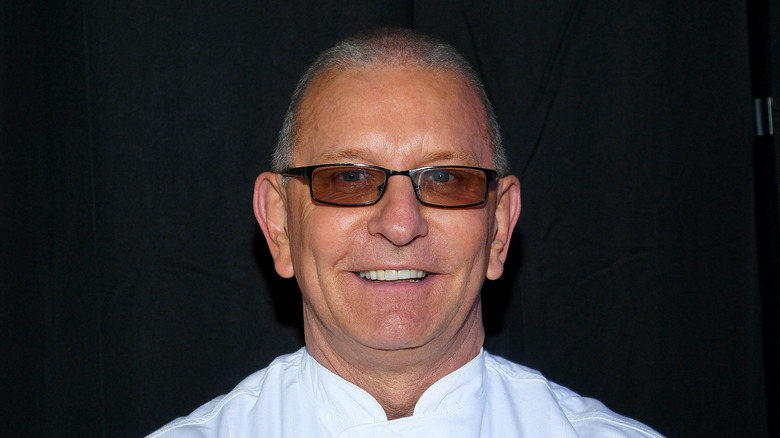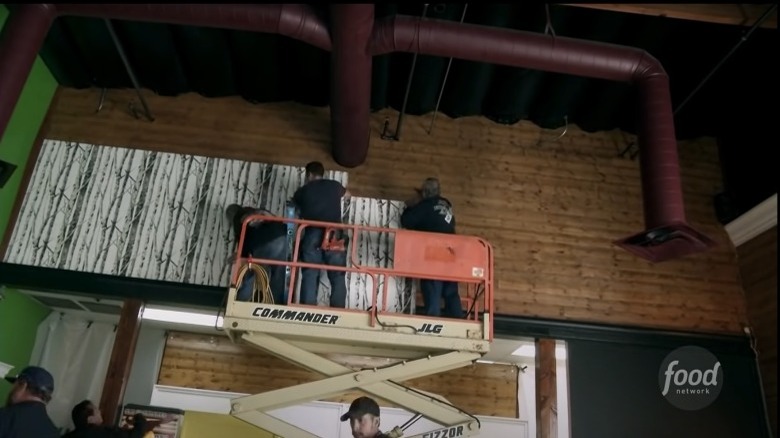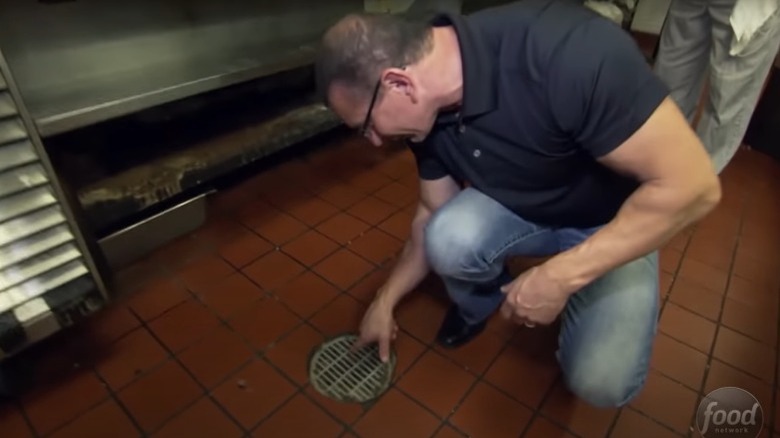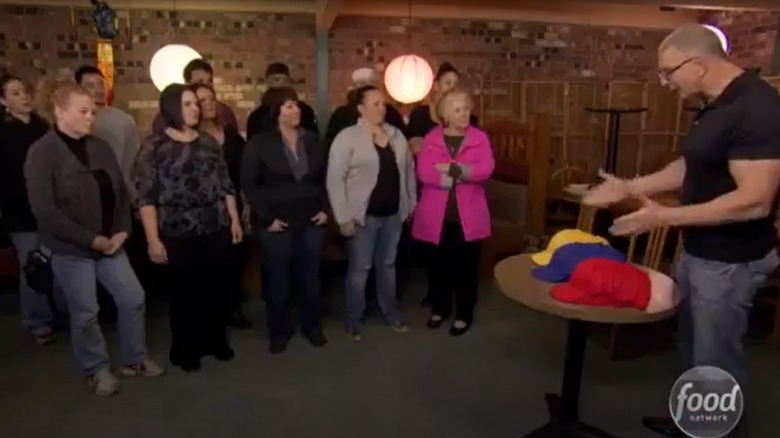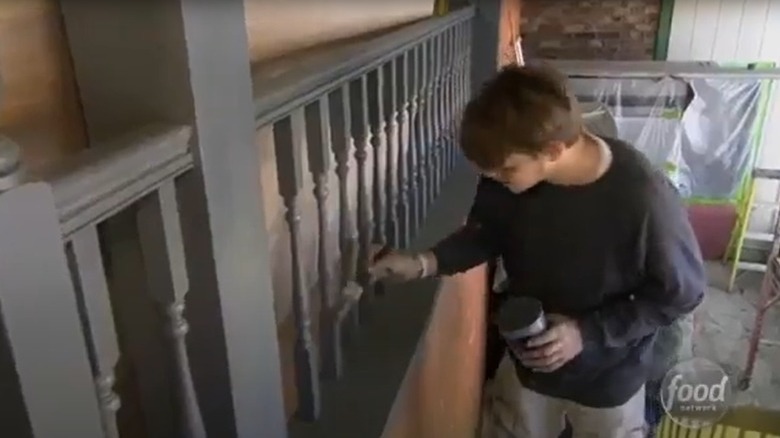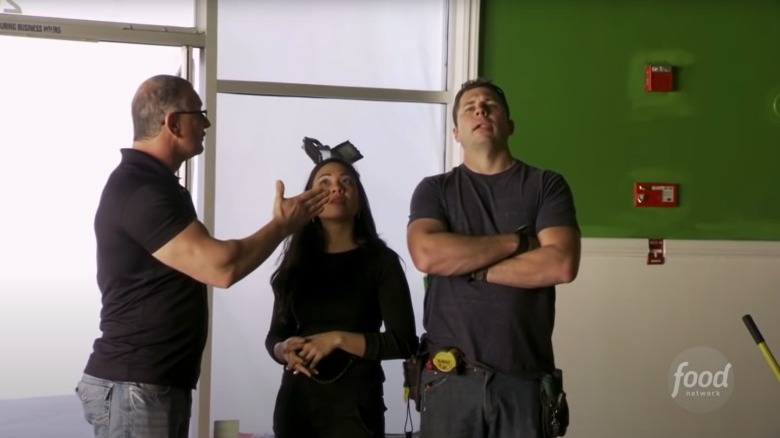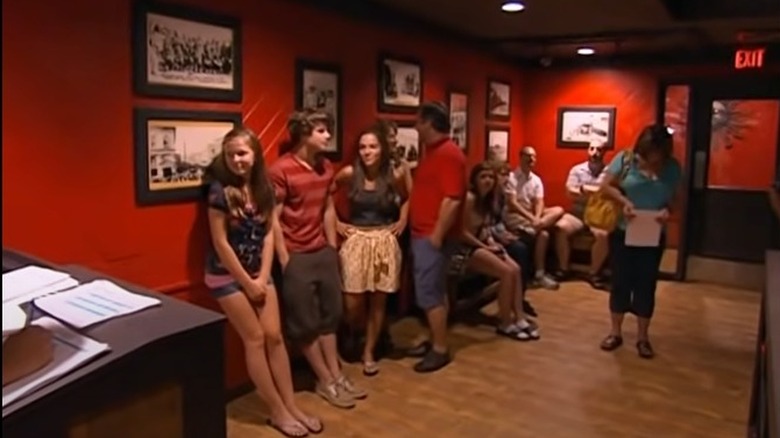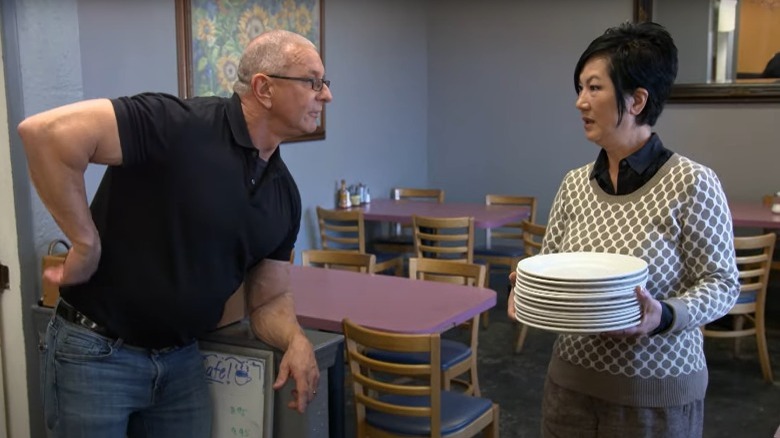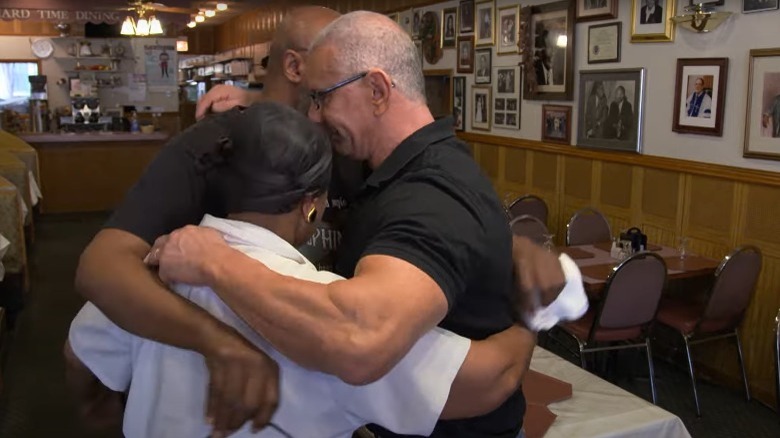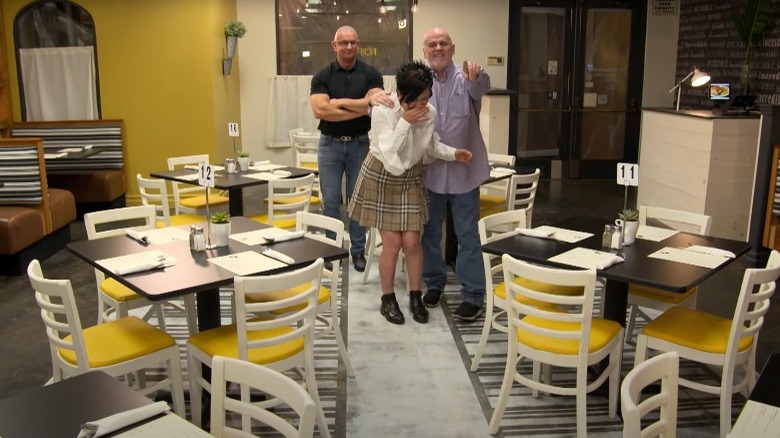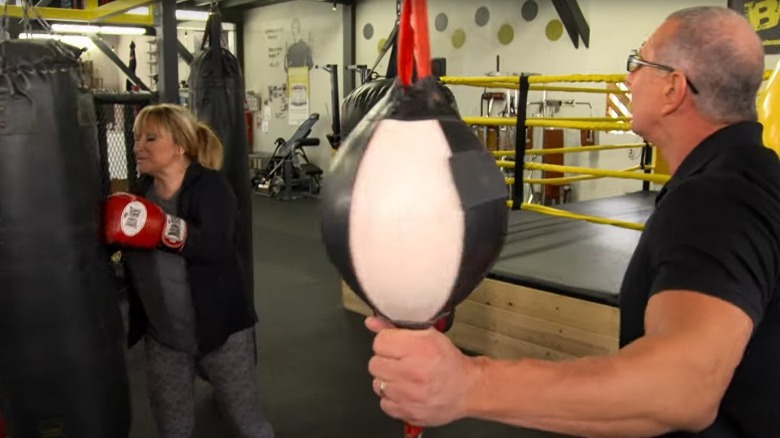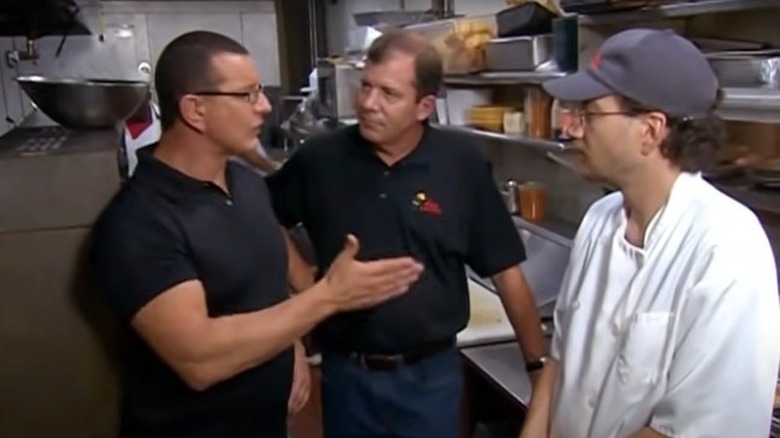What The Cameras Don't Show You On Restaurant: Impossible
Food Network's "Restaurant: Impossible" shows chef Robert Irvine traveling around the country saving restaurants. In a 2020 interview with BUILD, he said that 1,000 restaurants close every week in the United States. Lucky for them, Irvine and his crew are on a constant lookout to help restaurants in distress, and they come with two decades of experience revamping 250-odd restaurants (via Restaurant News).
In the reality show, we see Irvine lobbing harsh words at restaurant owners who seem too hesitant to accept change, but as the episode progresses, there is usually a pivot in the attitude of the restaurant owners who seem more willing to listen to Irvine's critiques. Finally, there is the big reveal, which most times leaves the owners, and sometimes Irvine himself, shedding tears of joy. All that drama takes place in 48 hours.
The viewers, however, only see a summary of the two days. Per Irvine, viewers don't get to see the discourse on menu, portion size, and profit-loss that he gives the owners. "You see the renovation going on but you don't see all the work that I'm doing behind the scenes," Irvine told The Big Lead. You also don't get to see what the crew members are up to when not tearing down the walls, or how exactly a restaurant ends up in the show. Here's what the cameras don't show you on "Restaurant: Impossible".
The construction and design team show up at the restaurants a day ahead
Every restaurant in "Restaurant: Impossible" gets a massive makeover. And while it may seem as if all work begins only after chef Robert Irvine shows up, it turns out that a part of his crew is already on location a day before the host arrives. The construction and design team scout the location and start prep work even before Irvine has had a chance to meet with the owners (via Robert Irvine Magazine). Per the construction manager on the show, Tom Bury, "That's our Day Zero day. I fly in. I walk around. We set up our tool stand, which is a huge part of that day because we set up the same exact way every single time so we know where everything is. Then I'm walking through with the designer." At least, this was the case in the first 11 seasons of the series, until Irvine decided to adopt the "ambush" format in Season 12 (via Reality Blurred).
The new format, which had Irvine and his team show up at a restaurant unannounced, though seemed thrilling, just didn't sustain. What viewers might not know is that every change the crew makes in the restaurant needs a prior permit, and the issue with coming in unannounced was that they didn't have time to get permits beforehand. And this impacted their construction work, as Irvine told Reality Blurred. The show reverted to its old format, Season 14 onwards.
Robert Irvine and his team get little sleep during the filming of the episodes
In two days, Robert Irvine has to course-correct a struggling restaurant into becoming a money-making establishment. This is not an easy task, and it sometimes may include upending the entire business model and refurbishing almost every element of the interior. For example, the Missouri-based Poco's on the Boulevard, which was featured in Season 4 of the series, got a new coat of paint, had its flooring replaced, and its barstools changed. Ohio-based Rohrer's Tavern from Season 5, was given a new bar design and service station — all in a span of two days (via Food Network). This ambitious deadline makes us wonder: Do they ever get time to take a nap?
Surprisingly, yes. "I try to get at least three to four hours with the guys," construction manager Tom Bury told Robert Irvine Magazine. Bury and his team realized that even if they burnt the midnight oil, they didn't make much progress in their work. "By getting three hours of sleep, the work I can get done in that first hour we start is more than I would get done in those three hours of sleep," added Bury. As for Robert Irvine, he seems to have his routine sorted out — he is at the gym by 5 a.m. every day, per Modern Restaurant Management.
Some restaurants revert to their old ways after Robert Irvine's intervention
Every "Restaurant: Impossible" episode has a set format — it all starts with restaurant owners receiving a lambasting from Robert Irvine, followed by them trading barbs at each other, and then many minutes of intense construction work, and finally the grand reveal of the revamped place. But what happens after the crew leaves? As it turns out, per Reality TV Revisited, some of the restaurants revert to their old ways. Meglio's Italian Grill from Season 1 was one such restaurant. According to John Meglio, who owned Meglio's Italian Grill and Bar, Irvine's menu changes didn't fly with the restaurant's customers in Missouri. Meglio had to bring back the frozen beef cannelloni, which Irvine had axed from the menu in favor of fresh items. "What he [Robert Irvine] didn't know is that people here have been eating frozen pasta from this one supplier in St. Louis for the last 50 years," he told The New York Times.
The menu changes that Irvine made at the restaurants Valentino's and Italian Bistro in South Carolina lasted for just two weeks. Per a Reddit AMA session by a member of the family that owned the restaurants, Irvine's suggested menu addition, the arugula prosciutto pizza, was a flop. "In South Carolina not a lot of people knew what arugula or prosciutto was, not exaggerating. We got many phone calls asking what both of those words meant."
Sometimes, the budget goes beyond the set $10,000 per restaurant
As with the time, there is also a limit on Restaurant: Impossible's budget. Robert Irvine and his team only have $10,000 to spend on each restaurant project. To keep within this upper limit, the team makes it a point to look for materials that are inexpensive, but also durable, Tom Bury, the construction manager on the show, told Robert Irvine Magazine. It's done without compromising the quality of the materials, of course. He said, "to be honest, when I see something that I know won't last, I won't do it. So, it's a pretty easy argument for me to win because I just say no. And I know Robert won't let me do it. He doesn't want it if it's going to be cheap."
In some rare cases though, the renovation amount does spill over $10,000. Bury said that this happened infrequently, when, for example, they ran into a big problem, or had the need to get new silverware. According to Bury, "It's still a huge win. The results they get are usually worth $75,000 to $100,000." Despite the efforts, 115 of the 203 restaurants featured on the show have closed, reports reality food show tracker Food Network Gossip.
The Restaurant: Impossible team finds time to joke around
Being a part of the "Restaurant: Impossible" crew seems like a tough gig, what with having a tight budget, an even tighter deadline, and a fire and brimstone boss to report to. But designer Tanya Nayak and contractor Tom Bury — the duo who have been working together on the show since its beginning — say that atmosphere on the sets is not always teeth-clenching tense. "Maybe early on we weren't as familiar and goofing around with one another. But I feel like Tom [Bury] and I, we are brother and sister at this point; we pick on each other, but we love each other. And so we just love to give each other a hard time, it makes us all laugh," Nayak tells Robert Irvine Magazine. What about Irvine? Believe it or not, he plays the role of the instigator, per Nayak. "He thinks it's hysterical and loves to jump in," she says.
But before you picture Irvine chortling during a renovation, let's remind you that Irvine does spew words that sting. His team calls it "the Robert Factor," Bury tells Robert Irvine Magazine. No one, not even the crew members, is spared from facing Irvine's wrath. "He'll yell at me, we'll genuinely get in an argument, and two minutes later, we're joking around and laughing. It's that kind of relationship where we don't take anything personally. It's work," adds Bury.
Sometimes, customers have to wait outside for hours to step inside a restaurant's grand opening
A restaurant's big reveal, in the "Restaurant: Impossible" world, is when it throws opens its doors for customers to check out its new Robert Irvine redesign. To be part of this big night, customers have to pay and book their tables in advance, Robert Irvine tells BUILD. Sometimes, however, the crew takes longer to fix things, and the delay can put some excited customers in despairing moods. For the grand re-opening of the Italian Village Restaurant in Pennsylvania, Delco Times reports, customers had to wait for over an hour before they were let in. "The crew lined us up, once for 45 minutes, and then a second time in a second place for 30 minutes. We began to talk at this point if we wanted to bag out and go elsewhere. This just didn't seem worth the wait," one customer said.
In yet another big reveal, customers at Benton Street in Pennsylvania had to wait for 2 hours before they were seated at their tables. As reported in Discover Lehigh Valley, "The crowd pushed toward the front porch of the restaurant as storm clouds slowly rolled in overhead and made the whole process of getting inside, which everyone was trying to do, that much more important." Some customers ahead of a reveal in Milwaukee even got an email instructing them to bring a snack, just in case things got delayed (via Lori Loves Adventure).
Restaurants go through a selection process before being featured
The 48 hours of work that Robert Irvine and his team put in gets edited into a 42-minute episode. But the work for a particular episode, technically, starts way before the 48-hour timer starts ticking. For example, just identifying which restaurant Robert Irvine gets to save next is a task in itself. As Robert Irvine told BUILD, to be featured, restaurants have to send in a video or a written application, giving details about the money lost and family story, among other information. Irvine never gets to see these applications, but a separate team does.
This team is careful about which restaurants they pick. Jennifer Leonzi, whose restaurant Country Cow Restaurant and Bar was featured on the show, told Business NH Magazine, "They wanted to make sure they were not coming to a place that is actually making money. I had to give 10 years' worth of tax returns." Once the application is sent in, it takes a while before the owners hear back. An owner of a restaurant featured on the show told Reddit that the team only called back a little over a year later after they had applied.
Robert Irvine continues to keep in touch with some restaurant owners
Robert Irvine is not someone who cuts ties with the restaurant owners after giving them a two-day intense crash course on how to run their restaurants. It turns out that once you are part of the "Restaurant: Impossible" show, you are always on Irvine's radar. "I'm just not there for 48 hours and then all of a sudden, I'm gone. I'm in your life for the rest of your life, whether you like it or not, whether you fail or succeed," Irvine told Reality Blurred. It's no news that Irvine revisits some of the restaurants he had revamped previously to check how they are doing (via Food Network). But did you know that he hands out his personal phone number to some owners too?
When Irvine and his team revisited Perella's Ristorante in Rhode Island two years after they had renovated it in 2019, Irvine gave the owner, Perella, his phone number to reach him in case the restaurant needed help. We're not sure if Perella sent an SOS text, but did ring him up to send him a happy Thanksgiving message, per The Providence Journal. Jennifer Leonzi, the owner of Country Cow Restaurant and Bar, was handed Irvine's and his chef's phone numbers before they left. "I speak to his chef quite often and he gives me great ideas," she told Business NH Magazine.
Once filmed, it takes a couple of months for an episode to air on television
After filming a restaurant's overhaul, the "Restaurant: Impossible" team takes some time to edit all the footage. During the period between the filming and the episode's release, the owners are legally bound to not talk about the filming process to anyone. The owner of two Italian restaurants featured in the show's "Double Trouble" episode in Season 11 confirmed in a Reddit AMA that all restaurant employees had to sign a non-disclosure agreement. They couldn't talk about the experience until the episode featuring their restaurant aired, which was a couple of months after shooting. The owners of The Italian Village Restaurant in Ridley, Pennsylvania, per Delco Times, were also told not to talk about the changes their restaurant underwent.
The customers who attended the reveal of the restaurant were also expected to remain hush. "Every so often, diners were chastised for taking photos and video with their cell phones because the filming was supposed to be such 'top secret'," one diner told the Delco Times. According to a Redditor who was present at one of the restaurant's reveals on the show, "Their only rule was not to take pictures of the finished restaurant (so as not to ruin the surprise on the episode)."
Robert Irvine has a huge team traveling with him
While cameras, for the most part, follow Robert Irvine around the restaurant, what viewers often don't see is the large crew that accompanies him to every location. Prior to the pandemic, Irvine traveled around with a production team that included around 50 to 100 members, as he told Heavy. And many of them, as surprising as it may seem, were up by 5 a.m. and working out before starting their grueling work of revamping a restaurant (via Modern Restaurant Management). During the pandemic, however, Irvine's team shrank to 12. "They're doing double duty to make this happen. But guess why we do it: We care about our 'Restaurant: Impossible' family," he said in the premiere of "Restaurant Impossible: Back in Business" — a rebrand of the original show — in 2020. "Back in Business" had Irvine and his team travel by bus across states to check on the restaurants that they had previously worked on, per Heavy.
Besides the production crew, Irvine also has volunteers from the neighborhood help out with the revamp (via Foodservice Consultants Society International). Ahead of the taping of the episode featuring the Titusville-based restaurant Loyd Have Mercy, Food Network sent out a press release stating, "Those who are licensed or certified in painting, crafting, construction, remodeling, cleaning and decorating are needed," according to Florida Today.
Some personal stories of restaurant owners are edited out
Years of helping restaurants reverse their fortunes has taught Robert Irvine that there is more than one reason why a restaurant fails. It's not just poor business acumen, personal issues and illnesses also play a part, he told Foodservice Consultants Society International. Irvine has had to wear a therapist's hat at times during the filming of "Restaurant: Impossible." But the personal details of restaurant owners with particularly traumatic backstories are kept out of the show so as not to sensationalize their tragedies on television, FCSI reports.
Having said that, the show, according to some restaurant owners, doesn't always reflect the truth. Bill and Nancy Consentino, owners of Consentino's Ristorante in New York, were quite miffed that their episode's narrative showed the wife, Nancy, as overworked, and the husband, Bill, as not contributing enough — when in truth, the owners told Finger Lakes Times, this wasn't the case. According to the owner of another restaurant featured on the show, a lot of the scenes are producer-driven. "Producers will lead you with phrases like 'when Robert said this I felt ... ' and then you repeat and fill in the blank. The few staged moments didn't involve us speaking, just them saying 'sit at that table and look sad' or 'stand over there and do a group hug,'" they told Reddit.
